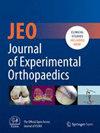Diagnostic and prognostic potential of biomarkers in femoroacetabular impingement syndrome: A systematic review
Abstract
Purpose
Early diagnosis of femoroacetabular impingement syndrome (FAIS) is essential. This systematic review aimed to identify biomarkers useful for diagnosing FAIS and predicting its progression to hip osteoarthritis. Our hypothesis was that there are biomarkers that are useful for the diagnosis and/or prognosis of FAIS. Our research questions were: (1) which biomarkers support diagnosis or screening of FAIS? and (2) which biomarkers predict disease progression?
Methods
A systematic review using the PRISMA guidelines was conducted to investigate the relationship between biomarkers and FAIS. The diagnosis of FAIS was based on the criteria used in each original study, typically involving clinical symptoms and radiographic evidence of CAM or pincer morphology. The protocol for the review has been published in PROSPERO. Literature search was performed using three databases: Embase, MEDLINE and Cochrane Library. The initial search yielded 683 articles of which 16 articles were included for final analysis. Data from a total of 2134 participants were analysed. Sixty-eight unique biomarkers associated with FAIS were identified and measured.
Results
Diagnostically, 19 biomarkers were identified, of which 12 could significantly detect a difference between patients with FAIS and healthy controls. Forty-two biomarkers predicting the association of FAIS with hip osteoarthritis or late FAIS were identified, of which 16 biomarkers were statistically significant. Only 4-aminobutyrate aminotransferase promoter (ABAT) and peroxisome proliferator-activated receptor gamma (PPARγ) were associated with both diagnosis and prognosis.
Conclusions
Biomarkers may support the diagnosis and monitoring disease progression in patients with FAIS. Twelve biomarkers may detect early changes, and 16 may predict progression to osteoarthritis. Further refinement is required to identify those most useful in clinical practice. ABAT and PPARγ may be linked to both diagnosis and progression. While primarily preclinical, these findings may improve diagnostic accuracy, reduce overtreatment and aid decisions regarding joint preservation strategies.
Level of Evidence
Level III.





 求助内容:
求助内容: 应助结果提醒方式:
应助结果提醒方式:


